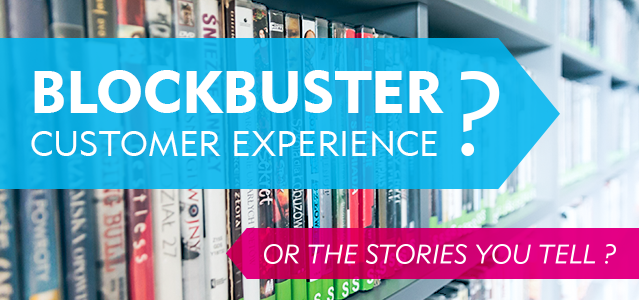Is Your Customer Experience a Blockbuster? Maybe It Shouldn’t Be.
You know it’s summer when the Hollywood blockbusters roll into your local theaters. All the special effects, familiar characters and cranked-up volume you can stand. (And yeah, that kid who kicks the back of your seat. Every time.)
Which got us thinking. From a customer experience standpoint, we can learn a lot from the blockbuster versus indie film battle.
Sure, Wonder Woman is a must see. But another big-budget sequel-prequel-remake of Pirates of the Caribbean, Planet of the Apes, Spiderman and Transformers this summer? Meh.
We’re not saying forget about being flashy. Just consider these customer experience lessons from Hollywood’s gems and rotten tomatoes:

1.Don’t treat your audience like a mass market
Blockbusters try to appeal to the lowest common denominator and broadest audience possible. Better to follow the indie film example: target your specific audiences, understand what they care about and make it personal.
The risk if you don’t? According to Salesforce research, more than half of consumers are likely to bail on brands if a company doesn’t at least try to personalize communications to them.
Today’s CMOs understand this. Delivering a customer experience that inspires loyalty starts with the customer, of course! Katy Keim, CMO of Lithium Technologies, says:
This may sound obvious, but the only way to deliver a stellar customer experience is to know and understand exactly who makes up your target audience, as well as what makes them tick.”
Palo Alto Networks took this approach when they teamed with Lightspeed for a new partner recognition program. The company wanted a creative approach to encourage system engineers to pursue and complete their certifications with Palo Alto Networks.
The resulting invitation-only program, CYBERFORCE, offers exclusive benefits that get even better as you advance to higher levels within the program. At its heart is an understanding of what the CYBERFORCE audience cares about: being part of an elite group who are instrumental in protecting our digital way of life by preventing successful cyberattacks.

2. Have something to say that’s relevant
Many blockbusters re-hash previous offerings and suck the life out of franchises. Did we mention Pirates of the Caribbean?
Indie films, in contrast, offer innovative approaches and a unique voice. Like last year’s small-budget but distinctive Moonlighting, which went on to win Best Picture. (Or was that La La Land? Whatever Bonnie and Clyde said).
Your customers want to hear you say something important, and research backs that up. An IDC / Salesforce study found 83 percent of B2B buyers appreciate hearing from you if you are relevant and contextual.
So much for style over substance. While you might use some funny cat videos to draw in the crowd, you need substance if you want them coming back for more.

3. Throw out the formula
Unlike formulaic blockbusters, indies use thoughtful plot development to dig beneath the surface and deliver the unexpected. Who better to explain than an indie film director, Nicolas Winding Refn, who directed Drive and last year’s The Neon Demon. Refn says:
What you have now is an endless void of noise, filled with stars. You can just search the universe forever. And things will get lost, because the noise is so gigantic that it will drown in itself, so I have to come up with plans to make the star bright enough to resonate.”
Strong brands, like good movies, resonate with their audiences.
Cisco wanted to drive more engagement with the 2,400-person inside sales team at CDW, one of Cisco’s key distribution partners. What would capture attention? Go Beyond, an incentive program for CDW employees to sell Cisco products.
With this program, Cisco and CDW knew we had tapped into an aspirational and creative theme that would cut through the noise. A star bright enough to resonate.

4. Content is an experience
Indie films have discovered a clear, relevant story can be more of an experience than any blockbuster.
That’s the power of content – the stories you tell that not only reflect your brand, but also are part of the experience customers have with your brand.
Traction CEO Adam Kleinberg tells Ad Age readers that people experience stories, and storytelling is more important than ever to help brands connect with customers. He adds:
The big difference today is that the term “creative (content)” can apply to every touchpoint of your customers’ experience. With it, you can build love, desire and customer loyalty.”
The lesson? Don’t churn out weak content like so many blockbuster movies do. Create content that gives your customer an experience worth their time and attention.

5. The indie approach pays off
Sure, indie films understand their audience and create an original and relevant experience. But they don’t make money, right?
Wrong. Indie films can make blockbuster money by winning over audiences and critics to score huge numbers at the box office.
What about the payoff for your customer experience efforts? A Temkin Group study found companies offering a “very good” customer experience have a significant advantage in customers who are willing to purchase more from them, trust them and forgive them if they make a mistake.
That’s huge, considering a Walker study that predicts by the year 2020 customer experience will overtake price and product as the key brand differentiator.
If you want an Oscar-worthy customer experience with an enviable ROI, leave the blockbusters to your local cineplex. Contact us at info@lightspeedmarketing.com to find out what an amazing customer experience feels like.
Without that kid kicking the back of your seat.
For more about customer experience, read:






